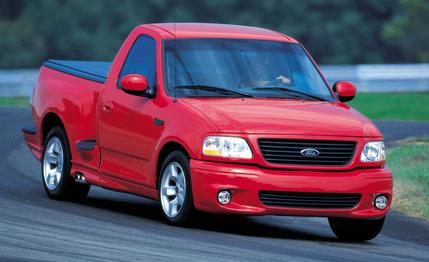 Short Take Road Test
Short Take Road Test
Few cars polarize the staff here as does Ford's high-performance pickup truck, the SVT F-150 Lightning. When we say polarize, we're not talking about the marketing term a GM exec might throw out to explain why the Aztek looks the way it does. ("The Aztek's style polarizes people.") No, the Lightning has broken our staff into those who think a high-performance pickup is dumber than bottled water and those who think it's cool.
Case in point: At our 10Best eliminations for 2001, where we grade each vehicle on a 100-point scale, Patrick Bedard gave the Lightning a three. Brock Yates gave it an 85. We expect the Lightning evokes a similar reaction from you, and for 2001, the Lightning either gets dumber or better -- it's got more horsepower, a shorter final-drive ratio, and subtle trim changes, including a new grille and front bumper, and clear lens covers for the taillights.

Introduced in 1993, the original Lightning followed a tried-and-true Detroit formula: Install a big engine in a small body. Small in pickup-speak means a two-wheel-drive regular-cab body, into which Ford slipped a 240-hp, 5.8-liter V-8. Performance was good for a pickup -- 0 to 60 in 7.2 seconds, 15.8 seconds in the quarter at 86 mph -- but nothing special in carland.
Twelve thousand of those Lightnings, priced at just under $22,000, were sold between 1993 and 1995. After 1995, the Lightning went on a four-year hiatus until a new model based on the current F-150 debuted in 1999.
That new vehicle used the same two-wheel-drive standard-cab layout -- although at a higher $31,000-plus sticker -- and knocked some of us off our feet. It could roar to 60 mph in 5.8 seconds and still tow a 5000-pound burden and carry 800 pounds of stuff. Others thought that making a pickup go fast, despite its speed-sucking flaws, such as major weight and a raised center of gravity, was a complete waste of effort.
Ford and SVT didn't try to convince the world that the Lightning made sense and produced a total of only 8966 of these hot-rod trucks in 1999 and 2000.
Thanks to a 90mm mass airflow meter (10mm larger than last year's), a larger intake-air opening in the fender well, and a higher-flowing intake manifold, SVT engineers have netted 20 more horsepower and 10 more pound-feet of torque from the supercharged V-8. The horsepower now stands at a massive 380 at 4750 rpm, and torque is 450 pound-feet at 3250 rpm. The Lightning runs $32,460 -- only $1460 more than last year's model -- and for that money, you get more horsepower than in any other production vehicle sold in the U.S.
For power freaks, the good news is the new Lightning has a shorter final drive -- 3.73:1 vs. 3.55:1 -- and that means acceleration times have improved dramatically. Sprints to 60 mph now take 5.2 seconds, 0.6 second quicker than in the previous Lightning. The quarter-mile now whooshes by in an amazing 13.8 seconds at 104 mph, faster than an SVT Mustang Cobra and only a few ticks behind the $55,675 Mustang Cobra R, which performs the feat in 13.0 seconds at 111 mph. Top speed also crept up 3 mph to 142.
Although the brakes remain the same four-wheel-disc setup, our test truck needed 12 fewer feet to come to a stop from 70 mph than did the '99 model, which needed 197 feet. Work the brakes hard, though, and they fade more than we like.
Unfortunately, a week of snowstorms that coincided with the Lightning's arrival prevented us from obtaining a skidpad number. We expect the new truck, which other than a switch from Monroe to Bilstein shocks continues to share the suspension and tires with the old one, to hit the same 0.81 g on the skidpad.
Speaking of snow, although the Lightning's smooth throttle tip-in and excellent-shifting tranny -- the best in Ford's stable -- do their best to dole out the power smoothly, the high-performance tires and forward weight distribution make it a sheer horror in the white stuff. Just park it when it snows.
On drier roads, the Lightning still has a stiff ride and a heavy feel, although it's less ponderous than every other pickup. Throttle response is, well, lightning fast, and only when you try to really hustle it through hard turns does the truck's suspension reveal its primitive pickup origins.
Many of us think the sheer thrill of the Lightning's thrust makes a strong case for this high-performance pickup. But that does not answer the question: What does Car and Driver think of the Lightning? That, of course, depends on whom you ask.